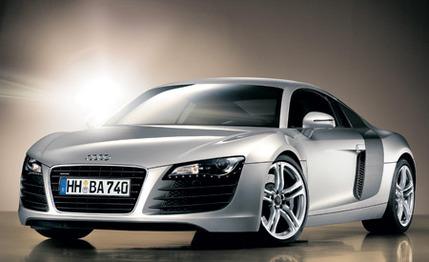
 First Drive Review
First Drive Review
Various German automakers have been promising to bring an exotic, high-powered mid-engined sports car to America ever since Mercedes showed the C111 Wankel-powered road burner in 1970. The closest they ever came was the recent $450,000 Porsche Carrera GT. Now Audi has shown a new middle-motored exotic that will come to market for less than a fourth of the Porsche's price.
It's called the R8, after the cars that won five of the past seven Le Mans races, and it closely resembles the Le Mans concept from the 2003 Frankfurt auto show. Under its aluminum skin, the R8 shares many of its mechanical bones with the Gallardo sports car made by Lamborghini, an Audi subsidiary.
Like the Gallardo, the R8 uses an aluminum space frame, but it's reworked, designed for fewer welds and lower cost. The suspension uses forged aluminum unequal-length control arms that look much like their Lamborghini equivalents. The two cars also share the Quattro driveline with power sent to the front wheels via a viscous coupling through a conventional manual six-speed transmission or a computerized, paddle-shifted gearbox that Audi calls R tronic and Lamborghini refers to as E-gear.
The major mechanical difference between the cars is the R8's use of the 420-hp V-8 from the Audi RS 4 rather than the Lambo V-10. A version of the V-10 should arrive about a year after the R8's introduction during the first half of next year, and it is expected to make at least 500 horsepower. Meanwhile, the high-revving V-8 gets a dry-sump lubrication system so it can be mounted lower to reduce the R8's center of gravity.
Another change is the adoption of optional computer-adjustable magnetorheological shocks. These are much like the shocks that come with the Corvette's F55 option, and they provide nearly instantaneous damping adjustments to match dynamic conditions.
The R8 looks completely different from the Gallardo. In place of the Italian car's angular, wedgy lines, the R8 delivers a more rounded profile that seemingly bulges with mechanical muscles. The R8 is the same width as the compact Gallardo but is about five inches longer and three inches higher on a wheelbase three-and-a-half inches longer.
From the front, the new Audi looks decidedly aggressive, the large corporate central grille flanked by a pair of stylized headlights in the curving front corners and two heavily straked air intakes that feed the front-mounted radiators. In the back, the R8 is equally captivating, with four tailpipes and more straked grilles to exhaust air from the engine compartment. From the side, however, the car's high profile and bulky C-pillars give it a visual heaviness.
Although it's a two-seater, the R8 has a panel behind each door that resembles the "helper" doors in a Mazda RX-8. In fact, these are fixed panels that Audi calls "blades." They'll come in colors that contrast with the rest of the car. Buyers will be able to specify them in carbon-fiber for that custom touch. In a Porsche-like move, you'll pay extra if you want your "blades" painted the same color as the rest of the body.
Inside, the R8 feels roomy and comfortable with a handsome instrument cluster, plenty of polished metal trim, and an interesting styling element that sweeps from the doors up and around the instruments before plunging toward the central console. The flat-bottom steering wheel looks especially racy and has just the correct rim thickness and squishiness.
The seat and the driving position seem comfortable, but you do sit low in this car and the cowl is on the high side. Moreover, we couldn't see any of the four corners from the driver's seat.
There's a useful shelf behind the two seats that will accommodate a pair of briefcases, the glove box is particularly deep, and there's even a pair of shallow cup holders in the console. But the front luggage compartment looks much smaller than the one in a Porsche Boxster.
Expect the R8 to arrive in America next fall at a price right around the $100,000 mark, although we suspect that various appearance and convenience options could add as much as 20 grand for those inclined to buy a fully loaded example. That makes for a pricey Audi, but only about 1000 of these cars will reach the U.S. annually.
Audi claims the R8 will reach 187 mph and hit 62 mph in 4.6 seconds (we expect 60 to come up in about 4.3). Corvettes excepted, that's decent performance value, and you won't see yourself coming and going in one of these cars even if you live in Beverly Hills.